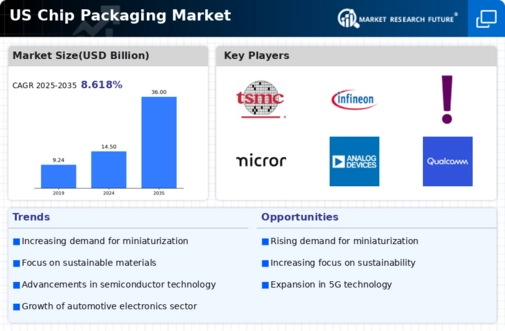The chip packaging market is currently characterized by a dynamic competitive landscape, driven by rapid technological advancements and increasing demand for miniaturization in electronic devices. Major players such as Intel Corporation (US), TSMC (TW), and Amkor Technology (US) are at the forefront, each adopting distinct strategies to enhance their market positioning. Intel Corporation (US) focuses on innovation through significant investments in research and development, aiming to lead in advanced packaging technologies. TSMC (TW), on the other hand, emphasizes partnerships with leading semiconductor firms to expand its service offerings, thereby solidifying its role as a critical player in the supply chain. Amkor Technology (US) is strategically enhancing its manufacturing capabilities, particularly in the area of advanced packaging solutions, to cater to the growing needs of the automotive and consumer electronics sectors. Collectively, these strategies contribute to a competitive environment that is increasingly centered around technological prowess and strategic collaborations.
Key business tactics within the chip packaging market include localizing manufacturing and optimizing supply chains to enhance efficiency and responsiveness. The market structure appears moderately fragmented, with several key players exerting considerable influence. This fragmentation allows for a diverse range of offerings, yet the collective strength of major companies like Intel Corporation (US) and TSMC (TW) shapes the competitive dynamics significantly. Their ability to innovate and adapt to market demands positions them as leaders, while smaller firms may struggle to keep pace.
In October 2025, Intel Corporation (US) announced a groundbreaking partnership with a leading AI firm to integrate artificial intelligence into its packaging processes. This strategic move is likely to enhance production efficiency and reduce time-to-market for new products, reflecting a broader trend towards digital transformation in the industry. The integration of AI could potentially streamline operations and improve quality control, positioning Intel as a frontrunner in the adoption of smart manufacturing practices.
In September 2025, TSMC (TW) unveiled plans to expand its advanced packaging facilities in the United States, a decision that underscores its commitment to meeting the growing demand for high-performance chips. This expansion is expected to bolster TSMC's production capacity and enhance its ability to serve key clients in the automotive and high-tech sectors. By localizing production, TSMC aims to mitigate supply chain risks and improve delivery times, which are critical factors in maintaining competitive advantage.
In August 2025, Amkor Technology (US) launched a new line of advanced packaging solutions specifically designed for automotive applications. This initiative is indicative of the company's strategic focus on high-growth sectors, as the automotive industry increasingly demands sophisticated packaging technologies to support electric and autonomous vehicles. By aligning its product offerings with market trends, Amkor is likely to capture a larger share of this lucrative segment, further solidifying its market position.
As of November 2025, current competitive trends in the chip packaging market are heavily influenced by digitalization, sustainability, and the integration of AI technologies. Strategic alliances are becoming increasingly vital, as companies seek to leverage complementary strengths to enhance their offerings. The competitive landscape is shifting from traditional price-based competition towards a focus on innovation, technological advancement, and supply chain reliability. This evolution suggests that companies that prioritize these aspects will likely emerge as leaders in the market, setting the stage for a new era of differentiation.
























Leave a Comment